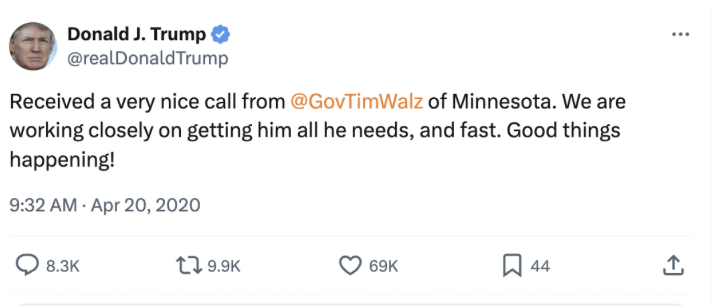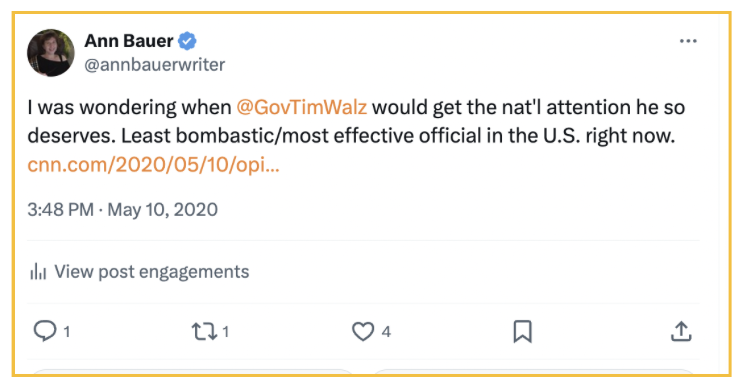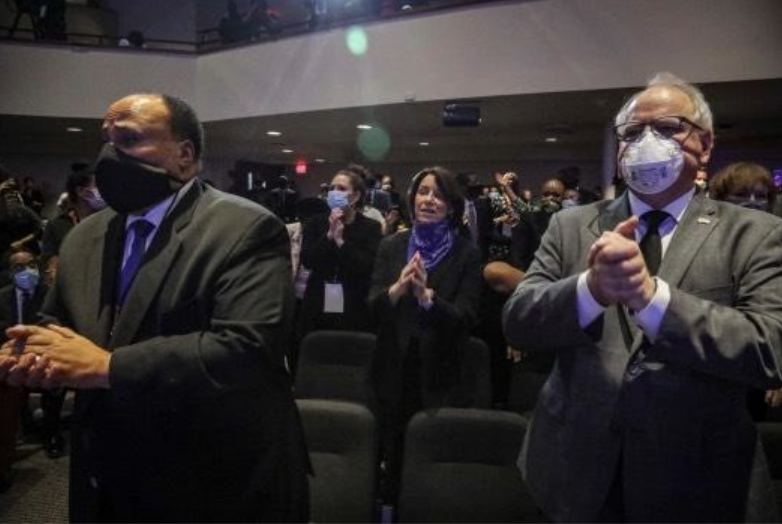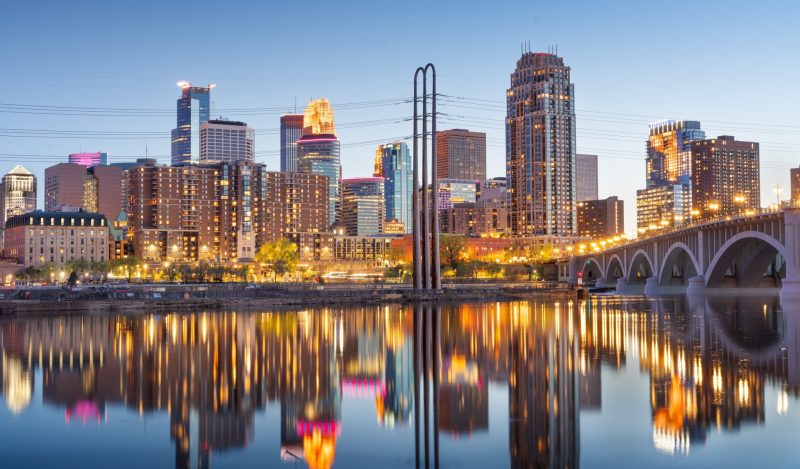In April of 2020, our portly, red-faced Aw, shucks governor, Tim Walz, was my hero.
He’d closed the public schools in our state on March 15th, but spoke—this former teacher and coach—with solemn grace. “I want to be very clear about this: A decision to close school has a magnitude of consequences,” he said. “This will change life in Minnesota.”
Our state was in good hands, it seemed, with a leader who was thinking through all the consequences. Then he alone among Democrat governors worked with the wacky Trump administration to plan. While Cuomo and Whitmer and Pritzker were sniping at the president, Tim Walz was making cordial calls to the Donald, working out resourcing for the ventilators we’d been told Covid patients would desperately need.
President Trump—then in his shutdown send-everyone-a-check phase of the pandemic—actually praised Gov. Walz and issued an uncharacteristically kind tweet.


I didn’t know it yet, but these were the dying days of my progressive optimism. I was tutoring neighborhood children, from a safe, six-foot distance, because their schools had been ‘temporarily’ closed. It was a beautiful spring. Governor Walz had promised that—after his first two-week shutdown in March, then his second two-week shutdown in early April, then his admission that we would probably have to live this way until mid-May—the end was in sight.
I corresponded with a friend living in New York City, the hub of viral activity. We agreed her situation was scary and her governor deranged. But mine!
“Minnesota may be the best place in the country right now,” I wrote. “It’s finally warm. The governor is a huggy bear kind of leader who’s been spot-on through this whole thing. People are mostly just fine.”
A few days later, CNN ran a story about Tim Walz’s approach to the pandemic and I tweeted this:


On May 25, everything changed.
In the Twin Cities, we heard about George Floyd a few hours after he was killed. We saw the footage on our local news stations. My husband and I were horrified, but not surprised; Minneapolis police had a long history of aggression and violence. We saw this as a tragic regional problem. But within 30 hours, our city—our neighborhood—was literally on fire.
We lived in St. Paul, across the river from where Floyd was killed, but the cities are seamlessly linked. Riots from Minneapolis traveled east and a stretch of University Avenue, less than a mile from us, went up in flames. Around us, all the stores where we’d been waiting in line for entry since Covid began were boarded up and closed. Target, Walgreens, Whole Foods.
We waited for Walz to speak. I expected him to come out and move among the heartbroken protesters—whose cause I sympathized with—but stand firm and excoriate the outsiders who were in our city throwing smoke bombs and looting. We needed a leader; we deserved one. The police had betrayed us (again). Our neighborhoods smelled of burning cars and decay. We couldn’t buy groceries or pick up prescriptions.
But after releasing a short safe televised statement denouncing the killing of Floyd, Governor Walz stayed locked inside his mansion. Night after night, newscasters begged him to reassure the public and try to establish order. He did nothing, except put us law-abiding citizens under strict curfews that police enforced by firing paintballs at people who stepped outside their doors.
Remember that scene in The Texas Chainsaw Massacre where the young woman is running from the man with the chainsaw, flags down a car and jumps in with relief…only to realize the driver is working with the killer? That’s a florid but not inaccurate analog for how I felt. The governor I’d been trusting to “keep us safe” hid while the city raged and burned. His contribution was to threaten and lob things at us when we stepped outside to walk our dog.
I don’t know if Tim Walz changed that week, or I did, or both. But what I saw as his cowardice and failure to lead just continued. When Minneapolis mayor Jacob Frey called Walz for help, the governor not only stonewalled, he savaged Frey, saying, “I don’t think the mayor knew what he was asking for”—and demeaned National Guard troops in the same shouty interview, calling them “19-year-olds who are cooks.”
It was all theater, big egos playing out on a media stage. Meanwhile, we in Minnesota had lost our social lives, our jobs, our pastimes, and our freedom to move at will. Everything felt dangerous and mean. We were still under Covid orders; now there was a layer of rolling curfews on top. But the rules were capricious and arbitrary. Who you were mattered. A lot.
Funerals, by Walz’s own executive order, were limited to 10 people, who were not allowed to hug, touch, or sing. My colleague’s beloved child died of a drug overdose during this time and didn’t hold a funeral because he and his wife could not—in their grief—make sense of the conflicting rules or choose which family to invite. Yet, Walz attended a massive indoor funeral for George Floyd—along with all the local notables who were cheering on his Covid regulations, including an unmasked can’t-ruin-my-hair Sen. Amy Klobuchar.
There was no satisfactory explanation, just a vague reference to “the greater good” and “civil rights” and doublespeak from Dr. Anthony Fauci—the unofficial Covid czar—who said he was “very concerned” about Covid-19 spreading at protests and celebrations of George Floyd’s life but “The only thing we can do as public health officials is to keep warning people to be careful.”
This, despite the fact that Governor Walz had set up a Covid “snitch line”—immediately upon writing stay-at-home orders in March—so Minnesotans could report one another for ‘violations’ and police could intervene. Residents who’d been asked to call and tattle on their neighbors for having a dinner party watched the governor clap, brush shoulders, and sing in praise to George Floyd, a man killed by the very police who’d been empowered to walk into any Minneapolis home, any time, because the owners had been accused by some anonymous caller of a Covid-related crime.


Am I just naive? Maybe. But this is the point where I became truly terrified of the man who’d commandeered my state—and my life. Twelve days before Thanksgiving, as Walz’s second lockdown went into effect (the snitch line not only still operating, but flooded with calls), his press conferences surged in what felt like a nightmarish Orwellian cabaret.
Winter was setting in. Minnesota skies were steely gray; the nights frigid and dark. We’d been banned from seeing our families over the holidays. The days ground on and Tim Walz looked like a man drunk on newfound power. He appeared on television frequently, talking about how he had to “dial back” our rights; wagging his face in disapproval like some sort of Frank Capra villain; shouting Covid numbers and scolding us for the number of hospital beds in use.
He’d bought a $6.9 million morgue for all the bodies (later it turned out no bodies were ever stored there; it was used as a warehouse for personal protective equipment). His Twitter account was a constant parade of “good news” about what food and alcohol we could order online. When teachers refused to go back into the classroom he washed his hands of the school issue—by January 2021, bars and restaurants were again operating at half-capacity but our two largest school districts with the most low-income students were still remote.
As the year went on I was more and more vocal, speaking out mostly about schools, taking the governor on. He was gearing up for a re-election campaign and because I was asking questions, people working in the statehouse started reaching out with rumors about a mammoth case of fraud. It involved hundreds of millions of federal dollars earmarked for child nutrition being distributed to sham NGOs run by Democrat donors and friends.
Problem was, none of our trusted news sources would report on the scheme. Only Sahan Journal, a ‘nonprofit newsroom dedicated to telling stories about Minnesota’s immigrants and communities of color,’ was brave enough to out the governor and his department of Education with a July 2021 story titled “Judge finds Minnesota Department of Education in contempt for go-slow approach to meal program.”
The founding publisher and CEO of Sahan Journal, Mukhtar M. Ibrahim—himself an immigrant from Somalia—reported the truth at great expense and damage to his ties in the progressive community. In his editor’s note, “Why Sahan Journal is reporting on alleged fraud in the federal meals program,” Ibrahim explained his reasoning and doubled down on his commitment to journalistic ethics.
It would take six months for our newspaper of record to cover the story and then, their stories were oddly focused on how other states had allowed fraud in meal programs, or how officials were acting and payments had been halted. The election came and went and Tim Walz won easily. It would be nearly a year of wrangling before the trial and actual reporting began.
As many as 47 people—mostly Somali and East African; many friends and donors of the Minnesota DFL—had participated in a scheme to steal at least $250 million (some accounts put the figure at $450 million) from a federally-funded child nutrition program administered by the MN Department of Education. Feeding Our Future was one of the largest successful Covid frauds in America. And it had all happened, after multiple warnings, right under Tim Walz’s thumb.
By the time a June 2024 audit by the Office of the Legislative Auditor found that the Walz administration had “created opportunities for fraud,” I was no longer expecting leadership or accountability. I’d gone from learning of that original phone call with Donald Trump in 2020—admiring our governor for being able to work with our crafty, egotistical, mean-tweeting president—to believing that Tim Walz was by far the more dishonest, uncaring, and self-promoting of the two.
Walz, true to form, shrugged off the massive waste and failure, telling his friends at the Star Tribune, “We can always do better,” but rejecting responsibility. Six weeks later, Kamala Harris chose him to be her potential vice president.
Tim Walz has done some good things as governor. He eliminated the arbitrary requirement of a four-year college degree for state jobs, enacted an effective insulin affordability act, and signed a law mandating “universal free meals” in Minnesota public schools. But the last seems mostly like a smokescreen for the millions of children who didn’t get fed to the Feeding Our Future fraud.
Since he became the presumptive VP candidate, stories have come out that I never knew—because media in my state has been running cover for Tim Walz for years. I had never heard about his drunken driving charge, speeding 96 mph in a 55-mile-per-hour zone, when he was a 31-year-old high school teacher—nor his campaign’s lies about the arrest when he was running for Congress in 2006. I did not know he had exaggerated his military rank or repeatedly claimed to have served in war when he did not.
But after the past four years spent living under the whims and ego-driven decisions of Tim Walz, none of it surprises me. He’s really just a lefty Trump, only with Hollywood and media on his side.
Join the conversation:


Published under a Creative Commons Attribution 4.0 International License
For reprints, please set the canonical link back to the original Brownstone Institute Article and Author.









